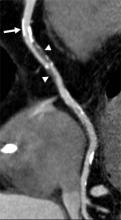CHICAGO – Patients with obstructive sleep apnea have more active atherosclerotic disease with a greater degree of vessel involvement and more vulnerable plaque than do patients without the disease, according to a retrospective matched cohort study presented at the annual meeting of the Radiological Society of North America.
"We found that those folks who have obstructive sleep apnea have the more dangerous form of plaque," said Dr. U. Joseph Schoepf of the Medical University of South Carolina, Charleston, at a news conference.
"This is the first time that a noninvasive test, namely coronary CT angiography, has been applied to this, to actually demonstrate it. The clinical relevance is that we have a noninvasive tool at hand that allows us potentially to care better for our patients who have that disease."
Patients with obstructive sleep apnea (OSA) repeatedly stop breathing during sleep due to airway collapse. It is a disease of obesity, and 30% of Americans are obese, said Dr. Schoepf. Diminishing the oxygen supply exposes the cardiovascular system to oxidative stress, and may render vessel linings more vulnerable to the formation of atherosclerosis. OSA has been linked to coronary artery disease, he noted.
Computed tomography is the only noninvasive test that can directly evaluate cardiac vessel patency and analyze the composition of atherosclerotic lesions on vessel walls, said Dr. Schoepf. Therefore, it was used to study the association between OSA and coronary artery disease.
Investigators performed a retrospective search for patients who had undergone CT of the heart and polysomnogram assessment for suspected OSA. One observer measured coronary artery calcium, known informally as hard plaque. Two observers in consensus analyzed heart CT data for the presence and degree of coronary artery narrowing or blockages. The presence and extent of noncalcified or soft plaque, also known as vulnerable plaque, were also evaluated. Noncalcified plaque frequently causes acute cardiac events such as heart attack and unstable angina.
The retrospective search revealed 97 patients who had undergone both heart CT for atypical chest pain or prior equivocal test, as well as a polysomnogram. Two patients were excluded because their polysomnogram was performed more than 36 months before or after the date of their cardiac CT.
Of the 95 remaining patients, 49 (23 women, mean age 61 plus or minus 11 years, average body mass index 33 plus or minus 8 kg/m 2 ) had documented obstructive sleep apnea by polysomnogram. The other 46 patients (24 women, mean age 60 plus or minus 12 years, average BMI 30 plus or minus 6 kg/m 2 ) were found not to have obstructive sleep apnea by polysomnogram. The investigators found no significant difference in age, gender, BMI, or cardiovascular risk factors between the two groups.
Agatson calcium scores (hard plaque) were not significantly different between the two groups (mean score 272 plus or minus 422 for the group with obstructive sleep apnea versus 241 plus or minus 415 without, P = .5). The presence of any type of narrowing in the heart vessels was found to correlate with the presence of obstructive sleep apnea (P less than .0001). The total number of vessels with any narrowing was also found to correlate with the presence of obstructive sleep apnea (P = .0008). In addition, the degree of narrowing in the highest grade of lesion correlated with obstructive sleep apnea (P = .0013).
In conclusion, Dr. Schoepf said that any instance where noncalcified plaque (‘soft’ or ‘vulnerable’ plaque) was measured showed a significant correlation with obstructive sleep apnea.
If the study’s findings are sustained by larger prospective trials, cardiac CT could emerge as a useful noninvasive tool for investigating the relationship between OSA and coronary artery disease.
The study was not funded, and Dr. Schoepf made no disclosures relevant to the study. His general disclosures are that he has served on the speakers bureau of, and/or received research grants from, the Bracco Group, General Electric, and Bayer AG. He also has served on the Siemens AG Medical Advisory Board.

